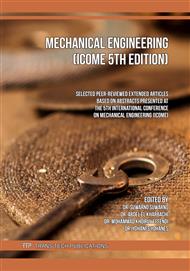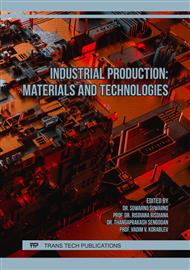[1]
S.C. Her, "Stress analysis of adhesively-bonded lap joints," Compos. Struct., vol. 47, no. 1–4, p.673–678, 1999.
DOI: 10.1016/s0263-8223(00)00052-0
Google Scholar
[2]
N.G.C. Barbosa, R.D.S.G. Campilho, F.J.G.D. Silva, and R.D.F. Moreira, "Comparison of different adhesively-bonded joint configurations for mechanical structures," Procedia Manuf., vol. 17, p.721–728, 2018.
DOI: 10.1016/j.promfg.2018.10.122
Google Scholar
[3]
W. Polini and A. Corrado, "Effect of adherends misalignment on the strength of single-lap bonded joints," Int. J. Adv. Manuf. Technol., vol. 106, no. 3–4, p.817–828, 2020.
DOI: 10.1007/s00170-019-04652-8
Google Scholar
[4]
F. Kadioglu and R.D. Adams, "Flexible adhesives for automotive application under impact loading," Int. J. Adhes. Adhes., vol. 56, p.73–78, 2015.
DOI: 10.1016/j.ijadhadh.2014.08.001
Google Scholar
[5]
G. Di Bella, G. Galtieri, E. Pollicino, and C. Borsellino, "Mechanical characterization of adhesive joints with dissimilar substrates for marine applications," Int. J. Adhes. Adhes., vol. 41, p.33–40, 2013.
DOI: 10.1016/j.ijadhadh.2012.10.005
Google Scholar
[6]
M.Q. dos Reis, M. D. Banea, L. F. M. da Silva, and R. J. C. Carbas, "Mechanical characterization of a modern epoxy adhesive for automotive industry," J. Brazilian Soc. Mech. Sci. Eng., vol. 41, no. 8, p.1–11, 2019.
DOI: 10.1007/s40430-019-1844-2
Google Scholar
[7]
D. Allman, "A Theory for Elastic Stresses in Adhesive Bonded Lap Joints," Q. J. Mech. Appl. Math., vol. 30, p.415–436, 1977.
DOI: 10.1093/qjmam/30.4.415
Google Scholar
[8]
R. Adams and N. Peppiatt, "Stress Analysis of Adhesive-bonded lap joint," J. Strain Anal. Eng. Des., vol. 9, p.185–196, 1974.
DOI: 10.1243/03093247v093185
Google Scholar
[9]
B. Zhao and Z. Lu, "A two-dimensional Approach of Single lap Adhesive Bonded Joint," Mech. Adv. Mater. Struct., vol. 16, p.130–159, 2009.
Google Scholar
[10]
M. Tsai, D. Oplinger, and Morton J., "Improved Theoretical Solution For Adhesive Lap Joints," Int. J. Solids Struct., vol. 35, p.1163–1185, 1998.
DOI: 10.1016/s0020-7683(97)00097-8
Google Scholar
[11]
Volkersen O., Rivet strength distribution in tensile-stressed rivet joints with constant cross-section. Luftfahrorschung, 1938.
Google Scholar
[12]
I. Pires, L. Quintino, J. F. Durodola, and A. Beevers, "Performance of bi-adhesive bonded aluminium lap joints," Int. J. Adhes. Adhes., vol. 23, no. 3, p.215–223, 2003.
DOI: 10.1016/s0143-7496(03)00024-1
Google Scholar
[13]
S. Kumar and P. C. Pandey, Behaviour of Bi-adhesive joints, vol. 24, no. 7. 2010.
Google Scholar
[14]
H. Özer and Ö. Öz, "Three-dimensional finite element analysis of bi-adhesively bonded double lap joint," Int. J. Adhes. Adhes., vol. Complete, no. 37, p.50–55, Sep. 2012.
DOI: 10.1016/j.ijadhadh.2012.01.016
Google Scholar
[15]
N. Ivanova, V. Gugleva, M. Dobreva, I. Pehlivanov, S. Stefanov, and V. Andonova, Applied Adhesive Bonding in Science and Technology, vol. I, no. tourism. 2018.
DOI: 10.5772/intechopen.80238
Google Scholar
[16]
N. J. Al-ramahi, Numerical Stress Analysis in Hybrid Adhesive Joint With Non-Linear Materials. 2018.
Google Scholar
[17]
R. J. C. Carbas, L. F. M. Da Silva, and G. W. Critchlow, "Adhesively bonded functionally graded joints by induction heating," Int. J. Adhes. Adhes., vol. 48, no. June, p.110–118, 2014.
DOI: 10.1016/j.ijadhadh.2013.09.045
Google Scholar



